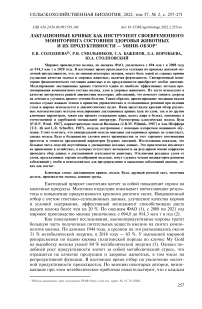Лактационные кривые как инструмент своевременного мониторинга состояния здоровья животных и их продуктивности - мини-обзор
Автор: Солоднева Е.В., Смольников Р.В., Баженов С.А., Воробьева Д.А., Столповский Ю.А.
Журнал: Сельскохозяйственная биология @agrobiology
Рубрика: Обзоры, проблемы
Статья в выпуске: 2 т.57, 2022 года.
Бесплатный доступ
Мировое производство молока, по оценкам ФАО, увеличилось с 694 млн т в 2008 году до 914,3 млн т в 2020 году. В настоящее время продолжается селекция по признаку высокой молочной продуктивности, что, по мнению некоторых авторов, может быть одной из главных причин ухудшения качества молока и здоровья животных, включая фертильность. Своевременный мониторинг физиологического состояния животных и их продуктивности приобретает особое значение. Моделирование лактационных кривых считается одним из наиболее эффективных методов прогнозирования компонентного состава молока, удоя и здоровья животного. Их часто используют в качестве инструмента ранней диагностики некоторых заболеваний, что помогает снизить затраты на лечение и улучшить прогноз течения болезни. Таким образом, прогнозирование эволюции надоев молока служит важным этапом в принятии управленческих и селекционных решений при ведении стада и широко используется в диагностических целях. Нами представлен краткий обзор различных математических методов моделирования лактационных кривых (как по удою, так и по другим ключевым параметрам, таким как процент содержания жира, выход жира и белка), описанных в отечественной и зарубежной специальной литературе. Рассмотрены классическая модель Вуда (P.D.P. Wood, 1967), параметрические модели Вилминка (J.B.M. Wilmink, 1987) и Али-Шеффера (T.E. Ali and L.R. Schaeffer, 1987), модели, построенные с помощью алгоритмов машинного обучения. Стоит отметить, что универсальной модели описания лактационных кривых не существует, однако модель Вуда в большинстве случаев имеет преимущества за счет хорошего соотношения простоты и точности предсказаний параметров будущих лактаций. Исследования показали, что большая часть моделей неустойчивы к уменьшению входных данных. Это практически исключает их применение в хозяйствах, в которых отсутствует возможность на регулярной основе корректно проводить сбор данных о лактационной деятельности животных. Отклонения реальных удоев от удоев, предсказанных хорошо подобранной моделью, могут служить четким индикатором развития заболеваний у особи и использоваться для предупреждения и выявления заболеваний вымени, таких как мастит.
Лактационная кривая, модель вуда, крупный рогатый скот, молочная железа, производство молока, влияние среды
Короткий адрес: https://sciup.org/142235670
IDR: 142235670 | УДК: 636.2:636.08.003:591.146 | DOI: 10.15389/agrobiology.2022.2.257rus
Текст обзорной статьи Лактационные кривые как инструмент своевременного мониторинга состояния здоровья животных и их продуктивности - мини-обзор
Ежегодный прирост населения влечет за собой повышение спроса на молочные продукты. Молочная индустрия показывает впечатляющие результаты в повышении продуктивности крупного рогатого скота. Направленный отбор с учетом генетико-селекционных данных, улучшение качества кормов и условий содержания, эффективный менеджмент способствовали росту надоев молока более чем на 20 %. По оценкам ФАО (1), с 2008 по 2021 год мировое производство молока увеличилось с 694,0 до 914,3 млн т в год (2).
Как показывают исследования, высокопродуктивные коровы тратят большую часть полученных питательных веществ именно на синтез компонентов молока. По данным 1944 года, в среднем на это расходовалось около 31 % метаболической энергии, в 2016 году — 65 %. У нынешней мировой рекордсменки по надою коровы голштинской породы по кличке My Gold на выработку молока уходит 84 % метаболической энергии (3). Однако подобный рост продуктивности влечет за собой метаболический стресс, что отражается на качестве продукции и здоровье животных, в том числе на репродуктивной функции. В настоящее время отбор на увеличение молочной продуктивности продолжается. По мнению некоторых авторов, возникающие при этом метаболические проблемы свидетельствуют, что с каждым
∗ Работа выполнена при поддержке РНФ , грант ¹ 19-76-20061.
днем в процессе селекции мы приближаемся к пределу адаптационных возможностей животного (4). Как следствие, особую важность приобретают средства своевременного мониторинга состояния здоровья животных и их продуктивности. Один из таких инструментов — моделирование лактационных кривых, которые представляют собой графическое изображение динамики молочной продуктивности крупного рогатого скота и других доме-стицированных видов животных за период лактации. Кривая лактации представляет собой график, по оси абсцисс которого отмечено время с момента отела, по оси ординат — один из параметров продуктивности: удой, состав по жиру и белку, а также соотношения компонентов молока (5). Так, величина соотношения жира и белка в молоке может служить показателем способности животного адаптироваться к периоду вскармливания, а также показателем скорости восстановления репродуктивной эффективности (6). После отела в период отрицательного энергетического баланса высокие значения соотношения жир:белок связывают со снижением потребления сухого вещества и увеличением мобилизации жира (7). Содержание жира и белка имеет обратную кривую по отношению к удою, что, вероятно, обусловлено эффектом разбавления (8).
У самок млекопитающих выработка молока во время лактации обычно характеризуется двумя фазами, которые соответствуют изменению потребности потомства в молоке (9). У коров фаза увеличения выработки молока продолжается с 5-6-х сут от родов до пика продуктивности (2-3-й мес), что отражает рост потребности теленка в молоке, фаза снижения секреции от пика до начала сухостойного периода (примерно 305-е сут лактации) связана с расширением рациона потомства и, следовательно, уменьшением важности молока как единственного источника питательных веществ (10).
С точки зрения физиологии, эволюцию выработки молока, а значит и форму лактационной кривой можно объяснить количеством и активностью секретирующих молоко клеток (11). Увеличение удоя с начала и до пика лактации объясняется возрастающей секреторной активностью эпителиальных клеток молочной железы (МЭК), при этом их пролиферация остается относительно стабильной на протяжении всего периода лактации (12). Снижение молочной продукции между 8-й и 23-й нед лактации обусловлено сокращением популяции МЭК вследствие увеличения скорости апоптоза, а на более поздней стадии — также снижением секреторной активности клеток. В фазу инволюции скорость апоптоза значительно превышает скорость пролиферации (13), и таким образом, количество эпителиальных клеток молочной железы в основном модулируется скоростью апоптоза (14).
Развитие молочной железы и процесс синтеза молока находятся под строгим контролем со стороны эндокринной системы, различных факторов роста и других генетических и эпигенетических факторов (15, 16). Кроме этого, важную роль в реализации генетического потенциала играют факторы внешней среды — питание, климат, сезон отела, фотопериод и циркадные ритмы, тепловой стресс, система раздоя и тип содержания (17). Возраст животного и его здоровье так же важны при составлении прогноза ожидаемой продуктивности (11). Все эти факторы вызывают изменение в составе молока и надоях и, следовательно, их стоит учитывать при моделировании кривой лактации (18).
Кривую лактации можно описывать с помощью математических моделей, что дает возможность прогнозировать лактационную деятельность. По этим моделям можно предсказывать целый набор ключевых параметров молока, отталкиваясь от параметров содержания коров и данных из предыдущих лактаций (8).
Нами представлен краткий обзор математических методов моделирования лактационных кривых, описанных в отечественной и зарубежной специальной литературе. Более подробно затронут один из самых популярных методов (метод Вуда, P.D.P. Wood, 1967) в применении к классической классификации лактационных кривых, данной А.С. Емельяновым (19). Рассмотрены модели кривых как по удою, так и по другим ключевым параметрам, таким как процент содержания жира и белка, а также выход жира и белка.
Прогнозирование эволюции надоев молока является важным этапом в принятии управленческих и селекционных решений по ведению стада и широко используется в диагностических целях (20). На основе анализа моделируемых функций прослеживается связь их математических характеристик и параметров, описывающих состояние здоровья особи. Так, меньшие значения производных в окрестностях максимума и наличие единственного экстремума характеризуют особь как более здоровую, имеющую устойчивую фертильность и эффективнее использующую более дешевые корма (21, 22). Таким образом, данные о составе молока могут быть использованы при корректировке рационов (23), а также для выявления заболеваний до появления клинических признаков, что помогает снизить затраты на лечение и улучшить прогноз течения болезни (2 4, 2 5).
Для молочного производства самыми ценными считаются коровы с выровненным типом лактации (26). Экономически более выгодно, когда корова производит умеренное количество молока в течение всего периода лактации, чем когда она быстро достигает пика продуктивности, после чего удой резко снижается. Стабильность лактации зависит от генетических факторов и таким образом может различаться у представителей разных пород, а также в зависимости от физиологических состояний (например, стельности) и внешних воздействий (2 7, 2 8). Экономическая целесообразность геномной селекции по признакам молочной продуктивности для достижения желаемой кривой продемонстрирована в ряде работ (2 9-3 1).
Физиологические основы цикла лактации коров . Воспроизведение потомства и обеспечение его молоком — два взаимосвязанных процесса. Известно, что во время стельности у коров разрастается ткань молочной железы, рост которой продолжается до тех пор, пока число клеток молочной железы не достигнет максимума. Вскоре после родов происходит снижение числа клеток вследствие апоптоза (запрограммированная гибель) секреторных клеток. Это снижение обычно наблюдается до окончания периода лактации. Молоко у коровы начинает секретироваться во время или непосредственно перед отелом. Весь цикл лактации можно разделить на два периода: период подъема (от отела до пика продуктивности) и период спада (от пика до сухостойного периода) (32). Повышение удоя в начале лактации напрямую связано со скоростью дифференциации клеток, а снижение удоя в конце периода лактации — с апоптозом этих клеток. Таким образом, вполне логично объединить в одну модель три процесса — дифференцировка секреторных клеток, их апоптоз и скорость секреции молока в расчете на клетку.
У крупного рогатого скота лактационный период в среднем составляет 10 мес (305 сут) и включает в себя несколько фаз: первая — от отела до выхода на пик продуктивности (до 70-100-х сут от отела); вторая — от пика лактации до середины лактации (до 150-200-х сут от отела); третья — с середины до окончания лактации (до 305-320-х сут от отела); четвертая — сухостойный период (45-60 сут от запуска) (33).
Подготовка к новому репродуктивному циклу (сервис-период) может длиться в среднем 65-80 сут. Такой срок считается оптимальным для подготовки к осеменению. Продолжительность стельности у крупного рогатого скота — 285 сут (рис. 1).
45-60 сут
Сухостойный период
■>
Ранняя и пиковая
। Сервис период । 65-80 сут
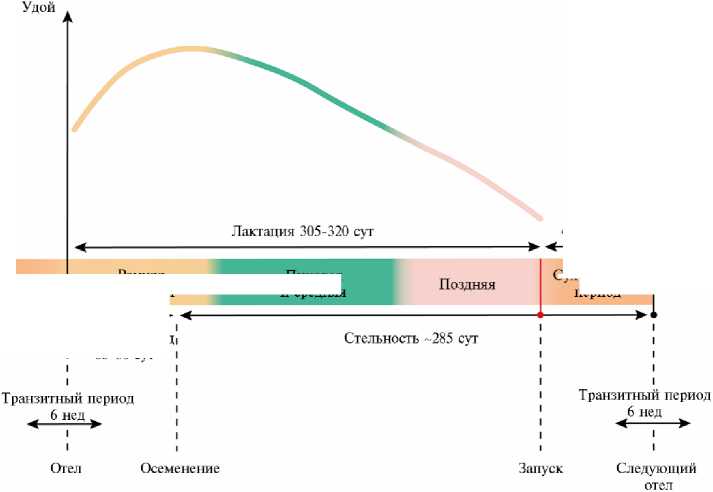
Рис. 1. Взаимосвязь циклов лактации и воспроизводства у высокопродуктивных коров.
Пиковая и средняя
У молочного скота беременность, как правило, наступает на фоне лактации. Значительное снижение секреции молока регистрируется между 100-ми и 200-ми сут стельности и не имеет выраженной зависимости от сроков с начала лактации (34). Изучая взаимосвязь этих двух состояний на молекулярном уровне, J.V. N o rgaard с соавт. (35) пришли к выводу, что гормоны, вырабатываемые фетоплацентарной системой, снижают активность пролиферации клеток молочной железы в период лактации и не влияют на апоптоз.
Форма кривой лактации демонстрирует потребность теленка в молоке: растущая секреция молока до пика лактации, отражает повышенный спрос в молоке, как единственном источнике питания, в то время как фаза снижения молочной продуктивности указывает на расширение рациона и, как следствие, снижение доли потребляемого молока (9).
Подходы к построению моделей лактационной деятельности. Математическое моделирование лактационных кривых позволяет предсказывать удой в зависимости от времени, прошедшего с рождения теленка. Модели могут принимать дополнительные параметры, такие как номер лактации, порода, параметры, связанные с кормом, и т.д. (36). Лактационная кривая чаще всего имеет Λ-образную форму, быстро возрастая в течение нескольких недель, после чего переходит в фазу убывания со значительно меньшей по величине производной. При ежедневных измерениях удоя обычно наблюдается биение показателя удоя вокруг тренда (19). Наибольшая продуктивность приходится на период между 4-й и 8-й нед после отела. За многолетнюю историю исследований были предложены модели разных видов — линейные, экспоненциальные, полиномиальные и многие другие (21).
Первые попытки описать результаты лактации были предприняты еще в 1920-х годах, и с того момента сложность и точность описаний только возрастали (37). Модели различаются степенью зависимости от параметров среды и времени (линейные, показательные, полиномиальные), числом этих параметров и способами описания основных характеристик кривых (точки экстремума, значения в точках экстремума, степень спадания нисходящей фазы и т.д.). В большинстве случаев кривые лактации строятся на основе данных о количестве полученного молока за период всей лактации коровы с идеей предсказать последующие. Для увеличения точности и устойчивости результатов модели лактационной деятельности можно учитывать изменение параметров содержания животных во времени (38).
Простые математические модели предсказывают лактационную деятельность коровы в начале лактации на основе фиксированного объема данных по предшествующей лактации. Также есть исследования, предлагающие модель для прогнозирования сразу всей кривой посредством построения структур глубокого обучения на основе всех исторических данных о корове. Такие модели позволяют находить на первый взгляд неявные закономерности. Например, в работе A. Liseune с соавт. (39) показано, что такая схема может превосходить стандартные модели в точности на протяжении уже первых 26 сут лактации. Ее можно использовать для выявления отклонения удоя от нормы, что позволяет сократить сроки обнаружения болезней. Эти прогнозы также целесообразно использовать при планировании бюджета ферм.
Математические модели лактационных кривых. Лактационной кривой по молоку называют функцию у=m [1] где t — время от рождения теленка, сут; y — количество надоенного за t-е сут молока, кг. Возможно, самой популярной моделью описания лактационных кривых является эмпирическая модель Вуда (P.D.P. Wood, 1967), где в качестве характеристик молока выступают удой, процентное содержание жира и белка, выходы жира и белка по массе (18, 21, 40). В общем виде модель выглядит следующим образом:
yt = atbect, [2] где yt — характеристика качества молока в сутки t; e — число Эйлера, параметры b, c определяют наклоны кривой до и после экстремума (функция в стандартной форме имеет один максимум), параметр à — коэффициент, связанный с абсолютными значениями. Максимум продуктивности определяется в точке tmax ”, [3] то есть время достижения пика продуктивности не зависит от параметра a. Для стандартной кривой лактации параметр b принимает положительные значения, а параметр c — отрицательные. Вариации b и c по знаку дают четыре различные конфигурации лактационных кривых: стандартная изоформа для b > 0, c < 0; возрастающая изоформа для b > 0, c > 0; убывающая изоформа для b < 0, c < 0; обратная изоформа для b < 0, c > 0.
Достоверность модели оценивается с помощью коэффициента детерминации. Коэффициент детерминации R\ad j ) показывает, какая доля дисперсии результативного признака объясняется независимыми переменными. Стандартная форма, используемая для описания кривых по молоку, показала самый большой в среднем уровень точности — для 64,7 % точек
R^^ adj ) > 0,75. Применение этой же формы для описания процентного содержания жира в молоке оказалось наименее точным — только для 18,7 % точек R 2 (ad j ) > 0,75. Эти факты указывают, что одна и та же конфигурация коэффициентов не может служить для описания всех параметров молока. Удой, выход белка и жира хорошо моделируются стандартной формой, в то время как процентное содержание жира и белка точнее будет описывать обратная форма.
В ряде исследований рассматриваются и другие характеристики молока. Например, отношение процента жирности молока к проценту содержания белка в молоке (Fat Protein Ratio, FPR) (41). Проверяется предположение, что указанный параметр играет ключевую роль в предсказании общей продуктивности коров. Были построены самые разные модели — Вил-минка (J.B.M. Wilmink, 1987), Али-Шеффера (T.E. Ali and L.R. Schaeffer, 1987), Го (Guo) и Сальвадора (Salvador), приближения с помощью полиномов Лежандра (Legendre polynomials). Критерии Байеса (Bayesian information criterion) и Акайке (Akaike information criterion) использовались для оценки точности моделей, а в некоторых случаях для этого рассматривалась корреляция между теоретически ожидаемым и фактическим значениями параметра FPR (41). Наибольшую точность показала предложенная T.Е. Али и Л.Р. Шеффером функция (42) как в случайной, так и в фиксированной модификации. В ходе исследования показано, что FPR коррелирует с показателем энергетического состояния животных, особенно на начальной стадии лактации. По совокупности исследований все рассматриваемые модели построения лактационных кривых давали практически одинаковые прогнозы. Основным фактором снижения точности послужило сокращение объема входных данных по зависимости суточного удоя от времени. Модели, основанные на эмпирическом приближении (модели Вуда, Вилминка и Али-Шеффера) оказались наименее устойчивыми к увеличению интервалов между измерениями. Из более ранних работ стоит отметить исследование, проведенное в 1953 году А.С. Емельяновым (19), где было проведено детальное исследование лактационных кривых с высокой частотой измерений на протяжении всего лактационного периода и предложена дифференциальная математическая модель.
Применение модели Вуда к разным тинам лактационных кривых. Мо -делирование лактационных кривых удоя. . Построенная лактационная кривая отражает индивидуальные особенности коровы, такие как состояние здоровья, склонность к раздою, устойчивость объема надоенного молока на протяжении цикла. Для демонстрации подробнее рассмотрим показательное исследование А.С. Емельянова, упомянутое выше (19, 4 3). Для кривых по удою им было предложено деление всех особей на группы по типу лактационной деятельности (то есть по виду кривых лактаций, различающихся высотой и устойчивостью): высокий устойчивый, двухвершинный, высокий неустойчивый, низкий устойчивый. Стоит отметить, что указанные типы были выделены среди особей различных пород при одинаковых условиях содержания.
Все эти кривые достаточно точно описаны самим А.С. Емельяновым с помощью формулы
У = -^- B(t -1) + 100 , [4] (Л - 1)
где у — процент нарастания удоя на следующие сутки относительно предыдущих, t — время от рождения теленка, A — процент разгона лактации, то есть на сколько процентов возрастает удой за первые два периода лактации
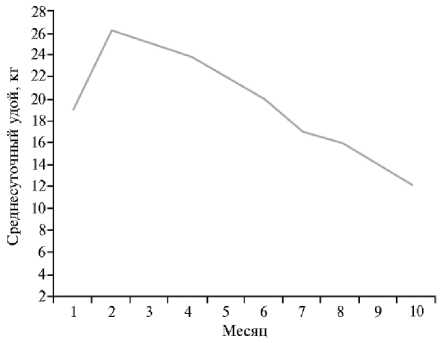
Рис. 2. Кривая удоя у коров с высокой продуктивностью и устойчивостью лактации. Адаптировано из работы А.С. Емельянова (19).
по сравнению с первым периодом, B — степень уменьшения процента нарастания. Эта формула по своей сути является дифференциальной при предельном переходе к бесконечно малым промежуткам измерений для коэффициентов A и B . Однако интегрирование этого уравнения для получения лактационной кривой трудоемко, поэтому большее распространение получили конструктивные модели, такие как модель Вуда, приведенная выше.
При подборе селекционных пар предпочтения отдают коровам, у которых кривые показывают наибольшую устойчивость. Пожиз- ненный удой и количество возможных лактации у них, как правило, выше.
-
I. Высокий устойчивый тип . Группа особей этого типа характеризуется малой скоростью падения удоя к концу лактационного периода. Лактация стабильно сохраняется на протяжении всех 300-305 сут. Изменения в
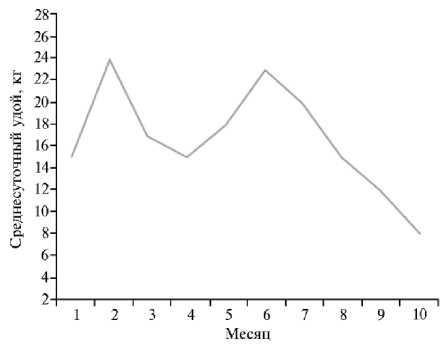
Рис. 3. Двухвершинная лактационная кривая. Адаптировано из работы А.С. Емельянова (19).
кормлении слабо отражаются на объемах молокоотдачи, животные способны длительное время поддерживать интенсивный обмен веществ, у них устойчивая сердечно-сосудистая и нервная системы. Как правило, интегральный удой у таких коров один из лучших в стаде. Такие особи крайне желательны для селекции (рис. 2) (43).
Эти кривые с хорошей точностью описываются стандартной формой модели Вуда, рассмотренной выше. Для оценки по лактационной кривой Ву- дом был предложен коэффициент устойчивости, выражаемый формулой
Р = - ( b + 1)ln( c ), [5] где b и c — коэффициенты, введенные в [2]. Для первого типа характерны высокие значения параметра устойчивости p > 2,2 (21).
-
II. Двухвершинный тип . В этой группе (рис. 3) величина удоя имеет несколько существенных периодов подъема и спада. С точки зрения лактационной деятельности животные похожи на коров 1-го типа, но в целом имеют более слабое здоровье, что не позволяет им поддерживать постоянный уровень обмена веществ, как следствие, на кривой лактации наблюдается чередование периодов отдыха и интенсивного молокообразования. Колебания лактации в этом случае не связаны с качеством кормления, поскольку условия содержания одинаковы. Приемлемой считается полная
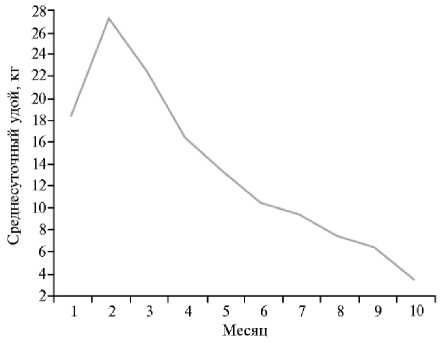
Рис. 4. Кривая удоя у коров с высокой продуктивностью и неустойчивой лактацией. Адаптировано из работы А.С. Емельянова (19).
300-суточная лактация, интегральные удои несколько меньшие, чем у коров с 1-м типом лактации. Считается, что эти животные могут вовлекаться в селекцию.
С помощью большинства стандартных математических моделей моделирование таких кривых невозможно. В подобных случаях лактационная кривая может быть описана полиномиальными рядами, учитывающими больший объем параметров (45, 46) .
-
III. Высокий неустойчивый тип. У этих коров в пер-
- вые месяцы лактации показатели удоя высокие, однако с 5-6-го мес они быстро падают. Предпочтительный период лактации 250 сут, при этом интегральный удой практически равен удою коров 1-го типа. Сердечно-сосудистая система таких животных не справляется с длительным напряжением обмена веществ. Подходят для селекции во вторую очередь, также имеют ограниченный период оплодо-
- творения (рис. 4) (43). Такие кривые также хорошо оцениваются с помощью
модели Вуда, однако имеют значительно более низкий коэффициент устойчивости p < 1,6.
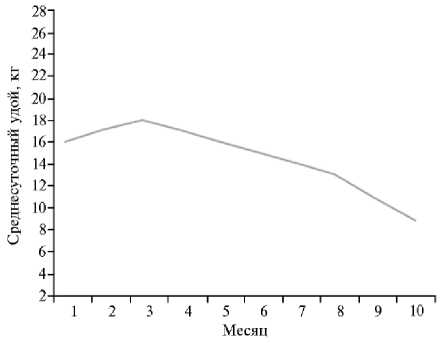
Рис. 5. Кривая удоя у коров с низкой продуктивностью и устойчивой лактацией. Адаптировано из работы А.С. Емельянова (19).
-
IV. Низкий устойчивый тип. Практически весь период лактации кривая удоя отражает стабильно низкие показатели. Особи обладают высокой резистентностью, имеют малый интегральный удой, стабильны (рис. 5) (43). Животные этого типа в большинстве своем ма-ломолочны, имеют слабый обмен веществ, недостатки в строении молочной железы, проблемы с сердечно-сосудистой системой и пищеварением. При выявлении данного типа лактационной деятельности у особей высокопродуктивных по-
- род, не рекомендуется их использование в племенной работе. Однако не стоит забывать, что указанный тип нередко встречается у представителей аборигенных пород и является нормой при отборе животных для дальнейшей селекции. Лактационные кривые такого типа можно описывать моде-
- лью Вуда с коэффициентом устойчивости p ® 2.
Моделирование лактационных кривых для компонентов молока. I. Построение лактационных кривых по жиру и белку. Как отмечалось выше, модель Вуда также используется для описания процента жирности и содержания белка. Примечательно то, что коэффициент ста- бильности вычисляется по той же формуле. Кривые, описывающие содержание жира в молоке, не имеют резких перепадов, однако обычно присутствует локальный минимум во временной точке максимума удоя молока. В течение первых 5 нед (молозивный период) лактации молоко, как правило, обладает наибольшей жирностью и высоким содержанием белка. На процентное содержание жира влияет тот же набор факторов, что и на удой, кривые, построенные для удоя и для жирности, имеют экстремумы в одних и тех же точках, что означает их прямую корреляцию (47). После первых 2 нед лактации краткосрочные гормональные изменения, вызванные рождением теленка, стабилизируются, и объем молока перестает сильно варьировать во времени.

Рис. 6. Схематичное изображение моделей Вуда для показателей жира (2) и белка (3) по отношению к удою (1) на одной координатной плоскости: А — выход белка и жира, Б — процент содержания белка и жира. Использованы данные молочной продуктивности особей голштинской породы коров. Адаптировано из работы A.M. Silvestre с соавт. (18).
Как видно из графиков (рис. 6, А, Б), эти же процессы почти не касаются основных компонентов молока — белка и жира, поэтому в начале лактации (первые сутки) возможно их аномально высокое процентное содержание в молоке. Выход белка и жира в килограммах снижается пропорционально удою после прохождения точки максимума, что связано с общим уменьшением интенсивности обмена веществ (48). Однако падение удоя всегда происходит быстрее, поэтому молоко к концу лактации становится несколько более жирным и более насыщенными белком ( 5, 18, 48).
Лактационные кривые как инструмент своевременной диагностики физиологического состояния животных . Параметр «соотношение жир:бе-лок» . Как известно, коэффициент FPR имеет высокую наследуемость и коррелирует с энергетическим состоянием животного.

Рис. 7. Отрицательная корреляции энергетического баланса (EB, ЧЭЛ — чистая энергия лактации, А) и соотношения жир:белок (FPR, Б) в 1-ю (1) , 2-ю (2) и 3-ю или следующие (3) лактации. Использованы данные молочной продуктивности особей немецкой голштинской породы коров. Адаптировано из работы N. Buttchereit с соавт. (41).
Сообщалось, что этот показатель может использоваться для заблаго- временного выявления заболеваний вымени. Также по FPR можно оценивать общее состояние особи, чтобы принимать решения о ее дальнейшем содержании. Например, важной характеристикой служит энергетический баланс (energy balance, EB), который позволяет регулировать рацион и более точно подбирать корма. Выявлены корреляции между FPR и EB, благодаря которым можно на ферме в процессе лактации получать данные о нехватке или избытке тех или иных компонентов рациона (рис. 7) (41).
Предсказания заболеваний но отклонениям лактационных кривых от нредсказанных значений . Построенные модели могут использоваться для предупреждения и выявления заболеваний вымени, таких как мастит. Например, можно построить модель для отдельных частей вымени, сравнивая отклонения от которой можно заметить эффекты заболевания. На основе величины удоя для каждой четверти вымени строится специальная улучшенная модель Вуда. Основываясь на кривых этих моделей и реальных показаниях удоя для частей вымени строится график их разности (QL). На рисунке 8 представлены кривые при клиническом мастите в случае острого QL_CM1 и более легко протекающего заболевания QL_CM2 в сравнении со здоровой частью вымени соответственно QL_NI1 и QL_NI2. Видно, что для QL_CM1 и QL_NI1 имеется общий пик падения продуктивности, а также через несколько доек появляется возможность узнать, какая конкретно четверть вымени заражена. Для QL_CM2 и QL_NI2 плавно снижается продуктивности пораженной четверти. Примечательно, что в этом случае здоровая часть вымени компенсировала потерю молока (вероятно, благодаря перераспределения питательных веществ) (см. рис. 8) (49).
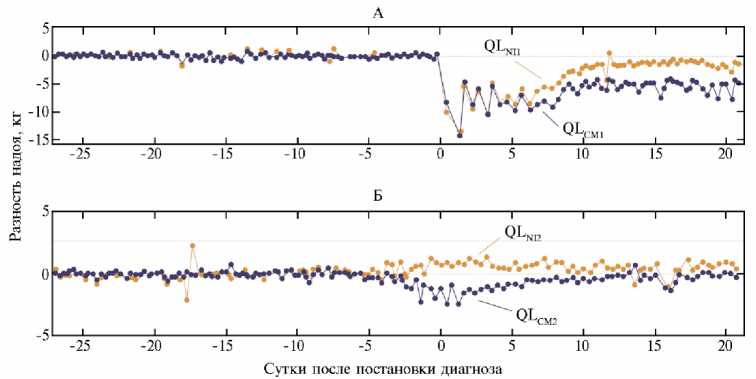
Рис. 8. Разность ожидаемых и наблюдаемых надоев (QL) при клиническом мастите для больной и здоровой части вымени коров в случае острого (А) и умеренно тяжелого (Б) течения болезни. Адаптировано из работы I. Adriaens с соавт. (49).
Моделирование лактационных кривых для оценки нлемен-ной ценности и учета влияния факторов среды. Совершенствование моделей лактационных кривых продолжается. В исследованиях A.B. Ab-delkrim с соавт. (38) использован усложненный подход к моделированию с целью уточнить потери молока в зависимости от различных факторов, воздействующих на животных. Подход использует суперпозицию сигнатурных графиков возмущений и ранее упомянутой функцией Вуда. Подразумевается, что существует некая эталонная, зависящая исключительно от генети- ческих признаков кривая, на которую накладываются возмущения, вызванные неидеальностью среды обитания (рис. 9). Учитывались влияния самых разнообразных параметров — от номера лактации до сезонности. Такой подход позволяет не только с высокой точностью вычислять влияние факторов среды на интегральный удой, но также оценивать генетический потенциал животных в целях дальнейшей селекции (38).
Геномная селекция — еще
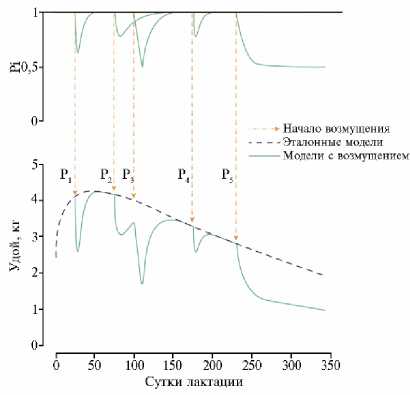
Рис. 9. Трансляция суперпозиции функций возмущений (P 1 -P 5 , вверху) на кривую удоя (внизу) в модели Вуда у коров по срокам лактации. Индивидуальная динамика возмущений выражена как доля невозмущенной лактационной кривой (P 1 -P 5 ). На графике удоя представлены невозмущенная и возмущенная динамика надоев. Использованы данные молочной продуктивности коз альпийской и заа-ненской пород. Адаптировано из работы A.B. Ab-delkrim соавт. (50).
одно важное направление использования данных лактационных кривых. Для этого животных с разными типами лактационных кривых необходимо прогенотипи-ровать по максимальному набору маркеров, связанных с молочной продуктивностью и качеством молока, с тем чтобы выявить корреляции между гаплотипом и типом лактационной кривой. В дальнейшем отбор подходящих животных можно будет проводить сразу после рождения либо на стадии подбора пар при разведении. Такой подход позволит значительно сократить расходы на выращивание и содержание малоперспективных для производства молока животных. Животные, чья лактационная деятельность характеризуется более низкими пиками и более высокой стойкостью кривой лактации, испытывают меньше проблем со здоровьем и воспроизводством и могут эффективно использовать более дешевые корма (22). Прогнозирование эволюции надоев молока может широко использоваться в диагностических целях, будучи важным инструментом при выборе стратегии управления и селекционной политики ведения стада (20).
Итак, прогнозирование эволюции надоев молока широко используется хозяйствами для принятия управленческих и селекционных решений. Для молочного производства самыми ценными считаются коровы с выровненным типом лактации. Моделирование лактационных кривых служит одним из наиболее эффективных методов предсказания различных параметров молока на основе фиксированного количества данных в начале лактации, следующей за лактацией с измеренными показателями. Учет наследственных и ненаследственных факторов, влияющих на лактационную деятельность, важен для получения более точного прогноза. Кроме того, достоверность модели следует оценивать, исходя из ее устойчивости при моделировании конкретных параметров. Некоторые компоненты молока, а также их соотношения могут выступать в качестве весьма точных маркеров физиологического состояния животных. Таким образом, моделирование лактационных кривых — важный инструмент своевременного мониторинга состояния здоровья животных и их продуктивности. Выявление заболеваний до появления клинических признаков помогает снизить затраты на лечение и улучшить прогноз течения болезни. Основная трудность регулярного мониторинга лактационной деятельности заключается в сложности проведения точных измерений и их последующего анализа, стоимости указанных процедур, а также в наличии технических возможностей. В последнее время для моделирования лактационных кривых начали использовать алгоритмы глубокого обучения, которые могут превосходить стандартные модели в точности (например, по предсказанию продуктивности в первые сутки лактации). При обучении такие модели учитывают статистику удоя за предыдущие лактации, параметры здоровья (в неявном виде), включая фертильность, и используют эти данные при моделировании сразу всей кривой. Эти прогнозы целесообразно использовать при планировании бюджета хозяйства.
Список литературы Лактационные кривые как инструмент своевременного мониторинга состояния здоровья животных и их продуктивности - мини-обзор
- ФАО, 2010 год. Продовольственный прогноз. Режим доступа: http://www.fao.org/3/a-ak349e.pdf. Дата обращения 20.11.2021.
- FAO, 2021. Food Outlook — Biannual Report on Global Food Markets. Food Outlook, November 2021. Rome, 2021 (doi: 10.4060/cb7491en).
- Baumgard L.H., Collier R.J., Bauman D.E. A 100-Year Review: regulation of nutrient partitioning to support lactation. Journal of Dairy Science, 2017, 100(12): 10353-10366 (doi: 10.3168/jds.2017-13242).
- Gross J.J., Bruckmaier R.M. Invited review: Metabolic challenges and adaptation during different functional stages of the mammary gland in dairy cows: perspectives for sustainable milk production. Journal of Dairy Science, 2019, 102(4): 2828-2843 (doi: 10.3168/jds.2018-15713).
- Stanton T.L., Jones L.R., Everett R.W., Kachman S.D. Estimating milk, fat, and protein lactation curves with a test day model. Journal of Dairy Science, 1992, 75(6): 1691-1700 (doi: 10.3168/jds.S0022-0302(92)77926-0).
- Loeffler S.H., de Vries M.J., Schukken Y.H. The effects of time of disease occurrence, milk yield, and body condition on fertility of dairy cows. Journal of Dairy Science, 1999, 82(12): 2589-2604 (doi: 10.3168/jds.S0022-0302(99)75514-1).
- Eicher R. Evaluation of the metabolic and nutritional situation in dairy herds: diagnostic use of milk components. Proc. 23 World Buiatrics Congress — Canada, 2004. Québec, QC, Canada, 2004: 34-37.
- Bouallegue M., M’Hamdi N. Mathematical modeling of lactation curves: a review of parametric models. In: Lactation in farm animals — biology, physiological basis, nutritional requirements, and modelization /N. M’Hamdi (ed.). IntechOpen, London, 2020: 1-20 (doi: 10.5772/intechopen.90253).
- Langer P. The phases of maternal investment in eutherian mammals. Zoology, 2008, 111(2): 148-162 (doi: 10.1016/j.zool.2007.06.007).
- Мурусидзе Д.Н., Легеза В.Н., Филонов Р.Ф. Технологии производства продукции животноводства. M., 2019.
- Svennersten-Sjaunja K., Olsson K. Endocrinology of milk production. Domestic Animal Endocrinology, 2005, 29(2): 241-258 (doi: 10.1016/j.domaniend.2005.03.006).
- Capuco A.V., Ellis S.E., Hale S.A., Long E., Erdman R.A., Zhao X., Paape M.J. Lactation persistency: insights from mammary cell proliferation studies. Journal of Animal Science, 2003, 81(15_suppl_3): 18-31 (doi: 10.2527/2003.81suppl_318x).
- Stefanon B., Colitti M., Gabai G., Knight C.H., Wilde C.J. Mammary apoptosis and lactation persistency in dairy animals. Journal of Dairy Research, 2002, 69(1): 37-52 (doi: 10.1017/S0022029901005246).
- Capuco A.V., Wood D.L., Baldwin R., Mcleod K., Paape M.J. Mammary cell number, proliferation, and apoptosis during a bovine lactation: relation to milk production and effect of bST. Journal of Dairy Science, 2001, 84(10): 2177-2187 (doi: 10.3168/jds.S0022-0302(01)74664-4).
- Ivanova E., Le Guillou S., Hue-Beauvais C., Le Provost F. Epigenetics: new insights into mammary gland biology. Genes, 2021, 12(2): 231 (doi: 10.3390/genes12020231).
- Самусенко Л.Д., Химичева С.Н. Влияние генетических факторов на воспроизводительную способность и молочную продуктивность коров. Главный зоотехник, 2016, 6: 22-29.
- Лоретц О.Г. Влияние технологии содержания и кратности доения на продуктивность коров и качество молока. Аграрный вестник Урала, 2013, 8(114): 72-74.
- Silvestre A.M., Martins A.M., Santos V.A., Ginja M.M., Colaço J.A. Lactation curves for milk, fat and protein in dairy cows: a full approach. Livestock Science, 2009, 122(2-3): 308-313 (doi: 10.1016/j.livsci.2008.09.017).
- Емельянов А.С. Лактационная деятельность коров и управление ею. Вологда, 1953.
- Caccamo M., Veerkamp R.F., De Jong G., Pool M.H., Petriglieri R., Licitra, G. Variance components for test-day milk, fat, and protein yield, and somatic cell score for analyzing management information. Journal of Dairy Science, 2008, 91(8): 3268-3276 (doi: 10.3168/jds.2007-0805).
- Macciotta N.P.P., Dimauro C., Rassu S.P.G., Steri R., Pulina G. The mathematical description of lactation curves in dairy cattle. Italian Journal of Animal Science, 2011, 10(4): e51 (doi: 10.4081/ijas.2011.e51).
- Jakobsen J.H., Madsen P., Jensen J., Pedersen J., Christensen L.G., Sorensen D.A. Genetic parameters for milk production and persistency for Danish Holsteins estimated in random regression models using REML. Journal of Dairy Science, 2002, 85(6): 1607-1616 (doi: 10.3168/jds.S0022-0302(02)74231-8).
- Dahl G.E. Physiology of lactation in dairy cattle — challenges to sustainable production. In: Animal agriculture /F.W. Bazer, G. Cliff Lamb, G. Wu (eds.). Academic Press, 2020: 121-129 (doi: 10.1016/B978-0-12-817052-6.00007-0).
- Koeck A., Jamrozik J., Schenkel F.S., Moore R.K., Lefebvre D.M., Kelton D.F., Miglior F. Genetic analysis of milk β-hydroxybutyrate and its association with fat-to-protein ratio, body condition score, clinical ketosis, and displaced abomasum in early first lactation of Canadian Holsteins. Journal of Dairy Science, 2014, 97(11): 7286-7292 (doi: 10.3168/jds.2014-8405).
- Chandler T.L., Pralle R.S., Dórea J.R.R., Poock S.E., Oetzel G.R., Fourdraine R.H., White H.M. Predicting hyperketonemia by logistic and linear regression using test-day milk and performance variables in early-lactation Holstein and Jersey cows. Journal of Dairy Science, 2018, 101(3): 2476-2491 (doi: 10.3168/jds.2017-13209).
- Филинская О.В., Ивачкина О.В. Характеристика показателей лактации коров ярославской породы. Вестник АПК Верхневолжья, 2017, 4: 12-17.
- Костомахин Н.М., Табаков Г.П., Табакова Л.П., Никитченко В.Е., Коротков А.С. Морфофункциональные свойства вымени, экстерьерные особенности и молочная продуктивность коров разных пород. Известия Тимирязевской сельскохозяйственной академии, 2020, 2: 64-84 (doi: 10.26897/0021-342X-2020-2-64-84).
- Coulon J.B., Perochon L., Lescourret F. Modelling the effect of the stage of pregnancy on dairy cows' milk yield. Animal Science, 1995, 60(3): 401-408 (doi: 10.1017/S1357729800013278).
- Dekkers J.C.M., Ten Hag J.H., Weersink A. Economic aspects of persistency of lactation in dairy cattle. Livestock Production Science, 1998, 53(3): 237-252 (doi: 10.1016/S0301-6226(97)00124-3).
- Togashi K., Lin C.Y. Modifying the lactation curve to improve lactation milk and persistency. Journal of Dairy Science, 2003, 86(4): 1487-1493 (doi: 10.3168/jds.S0022-0302(03)73734-5).
- Weller J.I., Ezra E., Leitner G. Genetic analysis of persistency in the Israeli Holstein population by the multitrait animal model. Journal of Dairy Science, 2006, 89(7): 2738-2746 (doi: 10.3168/jds.S0022-0302(06)72350-5).
- Knight C.H., Wilde C.J. Mammary cell changes during pregnancy and lactation. Livestock Production Science, 1993, 35(1-2): 3-19 (doi: 10.1016/0301-6226(93)90178-K).
- ФАО. Настольная книга фермера: Уход за молочной коровой в личном подсобном, малом семейном и фермерском хозяйствах. Рим, 2019: 28-29.
- Bertilsson J., Berglund B., Ratnayake G., Svennersten-Sjaunja K., Wiktorsson H. Optimising lactation cycles for the high-yielding dairy cow. A European perspective. Livestock Production Science, 1997, 50(1-2): 5-13 (doi: 10.1016/S0301-6226(97)00068-7).
- Nørgaard J.V., Sørensen M.T., Theil P.K., Sehested J., Sejrsen K. Effect of pregnancy and feeding level on cell turnover and expression of related genes in the mammary tissue of lactating dairy cows.Animal, 2008, 2(4): 588-594 (doi: 10.1017/S1751731108001626).
- Епимахов В.Г. Экологическая безопасность молочной продукции. построение лактационной кривой с учетом факторов, определяющих молочную продуктивность коров (обзор, имитационное моделирование, возможности). В сб.: Инновационное развитие науки: фундаментальные и прикладные проблемы. Петрозаводск, 2020: 366-381.
- Gaines W.L. Interpretation of the lactation curve. Journal of General Physiology, 1926, 10(1): 27-31 (doi: 10.1085/jgp.10.1.27).
- Abdelkrim A.B., Puillet L., Gomes P., Martin O. Lactation curve model with explicit representation of perturbations as a phenotyping tool for dairy livestock precision farming. Animal, 2021, 15(1): 100074 (doi: 10.1016/j.animal.2020.100074).
- Liseune A., Salamone M., Van den Poel D., Van Ranst B., Hostens M. Predicting the milk yield curve of dairy cows in the subsequent lactation period using deep learning. Computers and Electronics in Agriculture, 2021, 180: 105904 (doi: 10.1016/j.compag.2020.105904).
- Wood P.D.P. Algebraic model of the lactation curve in cattle. Nature, 1967, 216(5111): 164-165 (doi: 10.1038/216164a0).
- Buttchereit N., Stamer, E., Junge, W., Thaller G. Evaluation of five lactation curve models fitted for fat: protein ratio of milk and daily energy balance. Journal of Dairy Science, 2010, 93(4): 1702-1712 (doi: 10.3168/jds.2009-2198).
- Ali T.E., Schaeffer L.R. Accounting for covariances among test day milk yields in dairy cows. Canadian Journal of Animal Science, 1987, 67(3): 637-644 (doi: 10.4141/cjas87-067).
- Тюлькин С.В., Загидуллин Л.Р., Рачкова Е.Н., Ахметов Т.М., Кабиров Г.Ф. Типы лактационных кривых и коэффициент постоянства лактации у коров с разными генотипами каппа-казеина. Ученые записки Казанской государственной академии ветеринарной медицины им. Н.Э. Баумана, 2016, 226(2): 213-217.
- Garcı́a S.C., Holmes C.W. Lactation curves of autumn- and spring-calved cows in pasture-based dairy systems. Livestock Production Science,2001, 68(2-3): 189-203.
- White I.M.S., Thompson R., Brotherstone S. Genetic and environmental smoothing of lactation curves with cubic splines. Journal of Dairy Science, 1999, 82(3): 632-638 (doi: 10.3168/jds.S0022-0302(99)75277-X).
- Brotherstone S., White I.M.S., Meyer K. Genetic modeling of daily milk yield using orthogonal polynomials and parametric curves. Animal Science, 2000, 70(3): 407-415 (doi: 10.1017/S1357729800051754).
- Craninx M., Steen A., Van Laar H., Van Nespen T., Martin-Tereso J., De Baets B., Fievez V. Effect of lactation stage on the odd-and branched-chain milk fatty acids of dairy cattle under grazing and indoor conditions. Journal of Dairy Science, 2008, 91(7): 2662-2677 (doi: 10.3168/jds.2007-0656).
- Schutz M.M., Hansen L.B., Steuernagel G.R., Kuck A.L. Variation of milk, fat, protein, and somatic cells for dairy cattle. Journal of Dairy Science, 1990, 73(2): 484-493 (doi: 10.3168/jds.S0022-0302(90)78696-1).
- Adriaens I., Huybrechts T., Aernouts B., Geerinckx K., Piepers S., De Ketelaere B., Saeys W. Method for short-term prediction of milk yield at the quarter level to improve udder health monitoring. Journal of Dairy Science, 2018, 101(11): 10327-10336 (doi: 10.3168/jds.2018-14696).
- Abdelkrim A.B., Puillet L., Gomes P., Martin O. Lactation curve model with explicit representation of perturbations as a phenotyping tool for dairy livestock precision farming. Animal, 2021, 15(1): 100074 (doi: 10.1016/j.animal.2020.100074).

